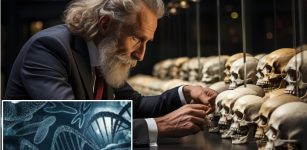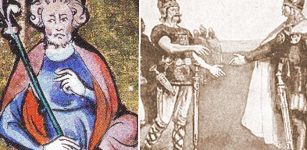Frightening Fenrir That Killed God Odin And Delivered Chaos And Destruction In Ragnarok’s Final Battle
A. Sutherland - AncientPages.com - In Norse mythology, the frightening giant Fenrir symbolizes nature's chaotic and destructive power. He represents tremendous dynamic forces coming from underground.
Fenrir was a gigantic monster wolf; he was so huge that his jaw stretched from the Earth to the sky. He was considered the wildest expression of nature.
 "Odin and Fenriswolf, Freyr and Surt" (1905) by Emil Doepler (1855–1922) - Public Domain.
"Odin and Fenriswolf, Freyr and Surt" (1905) by Emil Doepler (1855–1922) - Public Domain.
Fenrir ("He Who Dwells in the Marshes") is the most infamous of all creatures in Norse mythology. It is one of the most dangerous creatures from many ancient sources, such as Völuspá (Old Norse Voluspá), the first and best-known poem of the 'Poetic Edda,' compiled from earlier traditional sources in the 13th century.
It is also known from the 'Prose Edda' and 'Heimskringla' (the most famous of the Old Norse kings' sagas) dated to the 13th century.
Known to kill gods and goddesses, Fenrir played a significant role in pre-Christian Scandinavian beliefs. It was frequently depicted on numerous surviving runestones in Scandinavia and described in Old Norse literary sources.
According to the gods' prophecy, Fenrir, the son of the god Loki and his mistress and giantess, Angrboða, will kill the god Odin during the events of Ragnarok, the Norse Armageddon. But in turn, he will also be killed by Odin's son Víðarr.
One of the most famous Norse myths tells about the binding of this dangerous creature. The dwarves forged a chain made from the world's most secret powers, and the gods bound Fenrir in an attempt to control nature's never-ending destructiveness but in vain.
 “Odin and Fenrir” by Dorothy Hardy (1909). Public Domain
“Odin and Fenrir” by Dorothy Hardy (1909). Public Domain
Ledberg Stone - Ledbergsste nen), located in Östergötland, Sweden, probably depicts the final battle of the gods during Ragnarök. It's visible the wolf Fenrir attacking Odin and the ship Naglfar, and additional scenes show several other gods that meet their death.
The gods had tamed nature but only for a short time, and nature again showed its dangerous and uncontrolled power.
Fenrir managed to break free through his binding chains; he did it with great force and spread death and destruction. It happens in Ragnarok, the great and final battle.
Subterranean forces (earthquakes) set Fenrir free, and he opens his mouth so wide that his upper jaw captures heaven and his lower jaw the Earth. Fenrir's destructive, unlimited and uncontrolled power destroys lives in all nine worlds.
Odin dies fighting Fenrir, but the gods' prophecy is finally fulfilled. Víðarr, the son of Odin, avenges his father's death by killing the monster Fenrir at Ragnarok.
Written by – A. Sutherland AncientPages.com Staff Writer
Updated on December 27, 2022
Copyright © AncientPages.com All rights reserved. This material may not be published, broadcast, rewritten or redistributed in whole or part without the express written permission of AncientPages.com
Expand for referencesReferences:
Crossley-Holland, Norse Myths
Curtis, M. Legends of History
Leeming, D. The Oxford Companion to World Mythology
More From Ancient Pages
-
 Groundbreaking Discovery Reveals High Cognitive Abilities In Humans Who Lived 170,000 Years Ago
Archaeology | Feb 7, 2022
Groundbreaking Discovery Reveals High Cognitive Abilities In Humans Who Lived 170,000 Years Ago
Archaeology | Feb 7, 2022 -
 Encounter Between Neanderthals And Homo Sapiens – Genome Study Traces The History
DNA | Oct 18, 2023
Encounter Between Neanderthals And Homo Sapiens – Genome Study Traces The History
DNA | Oct 18, 2023 -
 On This Day In History: Peter The Great Defeats Charles XII Of Sweden At The Battle Of Poltava – On June 28, 1709
News | Jun 28, 2016
On This Day In History: Peter The Great Defeats Charles XII Of Sweden At The Battle Of Poltava – On June 28, 1709
News | Jun 28, 2016 -
 ‘Homo Erectus’ From Gongwangling Could Have Been One Of The First Human Beings 1,6 Million Years Ago
Archaeology | Jun 14, 2022
‘Homo Erectus’ From Gongwangling Could Have Been One Of The First Human Beings 1,6 Million Years Ago
Archaeology | Jun 14, 2022 -
 Tartarus – The Land Of The Dead – Mysterious Underground World
Featured Stories | Sep 13, 2015
Tartarus – The Land Of The Dead – Mysterious Underground World
Featured Stories | Sep 13, 2015 -
 Intriguing Beautiful Medieval Key Discovered In Claverham Village, UK
Artifacts | Oct 10, 2023
Intriguing Beautiful Medieval Key Discovered In Claverham Village, UK
Artifacts | Oct 10, 2023 -
 Smallest Ancient Thracian Brick Tomb – Discovered In Bulgaria
Archaeology | Oct 6, 2018
Smallest Ancient Thracian Brick Tomb – Discovered In Bulgaria
Archaeology | Oct 6, 2018 -
 Riddle Of The Hanging Gardens Of Babylon – Ancient Place Still Shrouded In Mystery – Part 1
Featured Stories | Jun 7, 2019
Riddle Of The Hanging Gardens Of Babylon – Ancient Place Still Shrouded In Mystery – Part 1
Featured Stories | Jun 7, 2019 -
 Surya: Hindu Sun God Who Illuminates The World, Our Lives And Disperses Darkness, Destroys Diseases, And Enemies
Featured Stories | Dec 1, 2020
Surya: Hindu Sun God Who Illuminates The World, Our Lives And Disperses Darkness, Destroys Diseases, And Enemies
Featured Stories | Dec 1, 2020 -
 Earliest Evidence For Domestic Yak – Revealed By Ancient DNA And Archaeology
Archaeology | Dec 15, 2023
Earliest Evidence For Domestic Yak – Revealed By Ancient DNA And Archaeology
Archaeology | Dec 15, 2023 -
 Ancient Roman Shrine And Over 1,100 Burials Found Beneath The Leicester Cathedral
Archaeology | Mar 7, 2023
Ancient Roman Shrine And Over 1,100 Burials Found Beneath The Leicester Cathedral
Archaeology | Mar 7, 2023 -
 Gigantic Unfinished Stone Structures Cut With Amazing Stone-Working Techniques
Civilizations | Sep 21, 2015
Gigantic Unfinished Stone Structures Cut With Amazing Stone-Working Techniques
Civilizations | Sep 21, 2015 -
 First Solid Scientific Evidence That Vikings Brought Animals To Britain
Archaeology | Feb 1, 2023
First Solid Scientific Evidence That Vikings Brought Animals To Britain
Archaeology | Feb 1, 2023 -
 Nephthys – Egyptian Funerary Goddess Who Also Protected The Pharaohs While They Were Alive
Featured Stories | Aug 15, 2021
Nephthys – Egyptian Funerary Goddess Who Also Protected The Pharaohs While They Were Alive
Featured Stories | Aug 15, 2021 -
 Surprising Discovery Of Almost Intact Roman Sanctuary With Temples In The Netherlands
Archaeology | Dec 23, 2022
Surprising Discovery Of Almost Intact Roman Sanctuary With Temples In The Netherlands
Archaeology | Dec 23, 2022 -
 Painted Komkom Vase With Longest Hieroglyphic Text Unearthed In Belize
Archaeology | Apr 24, 2019
Painted Komkom Vase With Longest Hieroglyphic Text Unearthed In Belize
Archaeology | Apr 24, 2019 -
 Is The Legendary Tsuchinoko Real?
Featured Stories | Aug 21, 2019
Is The Legendary Tsuchinoko Real?
Featured Stories | Aug 21, 2019 -
 Men Are Slowly Losing Their Y Chromosome – Is The Future Of Humanity In Danger?
Featured Stories | Nov 7, 2023
Men Are Slowly Losing Their Y Chromosome – Is The Future Of Humanity In Danger?
Featured Stories | Nov 7, 2023 -
 Secret Story Of The Ancient Bak’Ti Gods And Their Battle To Gain Control Over Humanity And Planet Earth – Told By Shamans
Featured Stories | Jun 23, 2018
Secret Story Of The Ancient Bak’Ti Gods And Their Battle To Gain Control Over Humanity And Planet Earth – Told By Shamans
Featured Stories | Jun 23, 2018 -
 Battle Of Assandun: The Great Battle In English History And A Brief Period Of Viking Dominion In England
Featured Stories | Apr 11, 2016
Battle Of Assandun: The Great Battle In English History And A Brief Period Of Viking Dominion In England
Featured Stories | Apr 11, 2016
